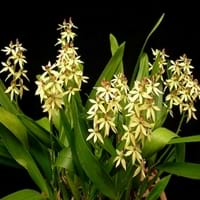Life Span
Perennial
Perennial
Type
Bulb or Corm or Tuber
Tender Perennial
Origin
South America, Argentina
World/Pandemic
Habitat
Temperate Regions
Rocky areas, Sandy areas, Swamps, Terrestrial, Woodlands
USDA Hardiness Zone
5-9
11-14
Habit
Clump-Forming
Clump-Forming
Flower Color
Light Blue, Light Purple, Silver, Sky Blue
Light Pink, Rose, Dark Salmon, Bronze, Tan, Sandy Brown, Sienna, Ivory
Flower Color Modifier
Bicolor
Bicolor
Fruit Color
Not Available
Not Available
Leaf Color in Spring
Green, Light Green, Gray Green
Green
Leaf Color in Summer
Light Green
Green
Leaf Color in Fall
Several shades of Green
Green
Leaf Color in Winter
Light Green
Light Green
Leaf Shape
Grass like
Long Linear
Plant Season
Spring
Spring, Summer
Sunlight
Full Sun, Partial Sun, Partial shade
Partial Sun, Partial shade
Type of Soil
Clay, Loam, Sand
Clay, Loam
The pH of Soil
Acidic, Neutral, Alkaline
Acidic
Soil Drainage
Well drained
Well drained
Bloom Time
Early Spring, Spring, Late Winter
Early Spring, Spring, Late Spring, Early Summer
Tolerances
Drought
Cold climate, Full Sun, Salt
Where to Plant?
Container, Ground
Container, Ground, Pot
How to Plant?
By dividing rhizomes, tubers
Divison, Stem Planting, Transplanting
Plant Maintenance
Medium
Low
Watering Requirements
Average Water Needs, Do Not over Water, Requires regular watering
Do Not over Water, Never Over-water, Requires regular watering, Requires watering in the growing season
In Summer
Lots of watering
Lots of watering
In Spring
Moderate
Ample Water
In Winter
Average Water
Average Water
Soil pH
Acidic, Neutral, Alkaline
Acidic
Soil Type
Clay, Loam, Sand
Clay, Loam
Soil Drainage Capacity
Well drained
Well drained
Sun Exposure
Full Sun, Partial Sun, Partial shade
Partial Sun, Partial shade
Pruning
Remove damaged leaves, Remove dead branches, Remove dead leaves
Cut or pinch the stems, Remove damaged leaves, Remove dead leaves
Fertilizers
All-Purpose Liquid Fertilizer
fertilize in growing season, Phosphate, Requires high amount of nitrogen
Pests and Diseases
Slugs, Snails
Bacterial soft rot, Brown Rot, Mealybugs, Spider mites
Plant Tolerance
Drought
Cold climate, Full Sun, Salt
Flower Petal Number
Single
Single
Fragrant Flower
Yes
Not Available
Foliage Texture
Medium
Coarse
Foliage Sheen
Matte
Not Available
Attracts
Bees, Birds, Hummingbirds
Insects, Mealybugs
Allergy
Not Available
Not Available
Aesthetic Uses
Showy Purposes
Beautification, Landscape Designing, Showy Purposes
Beauty Benefits
Not Available
No Beauty Benefits
Environmental Uses
Air purification
Air purification, Food for insects, Indoor Air Purification
Medicinal Uses
No Medicinal Use
No Medicinal Use
Part of Plant Used
Flowers
Flowers
Other Uses
Not Available
Decoration Purposes, Showy Purposes, Used as Ornamental plant
Used As Indoor Plant
Yes
Yes
Used As Outdoor Plant
Yes
Yes
Garden Design
Container, Lawns and Turf, Mixed Border, Rock Garden / Wall, Wildflower
Container, Feature Plant, Houseplant, Mixed Border
Botanical Name
Ipheion uniflorum
ENCYCLIA hanburyi
Common Name
Spring Starflower, Springstar
Encyclia, Orchid
In Hindi
Spring Starflower
आर्किड
In German
Frühling Borretsch
Orchidee
In French
Spring Starflower
Orchidée
In Spanish
primavera Flor de estrella
Orquídea
In Greek
άνοιξη starflower
εγκύκλιο
In Portuguese
primavera Starflower
orquídea
In Polish
Wiosna Starflower
orquídea
In Latin
Spring Starflower
Epidendrum
Phylum
Magnoliophyta
Magnoliophyta
Class
Lilopsida
Liliopsida
Order
Asparagales
Asparagales
Family
Liliaceae
Orchidaceae
Clade
Angiosperms, Monocots
Angiosperms, Monocots
Tribe
Gilliesieae
Epidendreae
Subfamily
Allioideae
Epidendroideae
Number of Species
Not Available
Season and Care of Spring Starflower and Encyclia
Season and care of Spring Starflower and Encyclia is important to know. While considering everything about Spring Starflower and Encyclia Care, growing season is an essential factor. Spring Starflower season is Spring and Encyclia season is Spring. The type of soil for Spring Starflower is Clay, Loam, Sand and for Encyclia is Clay, Loam while the PH of soil for Spring Starflower is Acidic, Neutral, Alkaline and for Encyclia is Acidic.
Spring Starflower and Encyclia Physical Information
Spring Starflower and Encyclia physical information is very important for comparison. Spring Starflower height is 10.20 cm and width 5.10 cm whereas Encyclia height is 40.60 cm and width 45.70 cm. The color specification of Spring Starflower and Encyclia are as follows:
Spring Starflower flower color: Light Blue, Light Purple, Silver and Sky Blue
Spring Starflower leaf color: Green, Light Green and Gray Green
Encyclia flower color: Light Pink, Rose, Dark Salmon, Bronze, Tan, Sandy Brown, Sienna and Ivory
- Encyclia leaf color: Green
Care of Spring Starflower and Encyclia
Care of Spring Starflower and Encyclia include pruning, fertilizers, watering etc. Spring Starflower pruning is done Remove damaged leaves, Remove dead branches and Remove dead leaves and Encyclia pruning is done Cut or pinch the stems, Remove damaged leaves and Remove dead leaves. In summer Spring Starflower needs Lots of watering and in winter, it needs Average Water. Whereas, in summer Encyclia needs Lots of watering and in winter, it needs Average Water.





